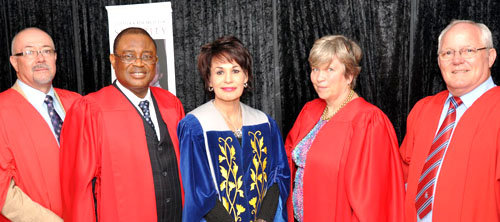 |
Prof. Frans Swanepoel (Centre for Sustainable Agriculture and Rural Development), Prof. Monty Jones, Prof. Driekie Hay (Vice-Rector: Teaching and Learning), Prof. Alice Pell (Cornell University, USA), and Prof. Izak Groenewald (Director of the Centre for Sustainable Agriculture and Rural Development) at the inaugural lecture of Prof. Jones as Professor Extraordinary.
- Photo: Stephen Collett |
Food stability is essential for stability in all countries around the world. Radical interventions, and not incremental changes, are necessary to end hunger and poverty in Africa, said Prof. Monty Jones, Professor Extraordinary in the Centre for Sustainable Agriculture and Rural Development at the University of the Free State (UFS), in his inaugural lecture.
Prof. Jones is Executive Director of the Forum for Agricultural Research in Africa (FARA) and Chairperson of the Global Forum on Agricultural Research (GFAR). In his lecture he focused on the contribution of agricultural research to development and food security in Sub- Saharan Africa.
He said Africa is not known for good politics to promote food production. Countries under invest in research, education, knowledge management, agriculture finance, etc. There is also uncertain and restricted access to land. He specially mentioned women’s access.
Sub- Sahara Africa moved from being a net exporter of food to a net importer of food (28%). “Government spending on agriculture and transport went down and stagnated. A mind shift is necessary. Africa has the resources. We must take advantage of the opportunities,” he said, and added: “Africa must create visionary and inspirational leaders and managers who can drive developmental issues.”
Prof. Jones emphasised that fact that nutritional security is just as important as food security. The number of hungry people has grown to more than a billion in 2009. Hunger is the most severe in the developing world, especially Africa. Added to this is Africa’s population growth that i s also higher than the rest of the world. It is estimated that the demand for food in Africa will double in the next 40 years.
“Research and development alone cannot win the war against hunger in Africa. Everyone has a role to play,” he said.
– Leatitia Pienaar.